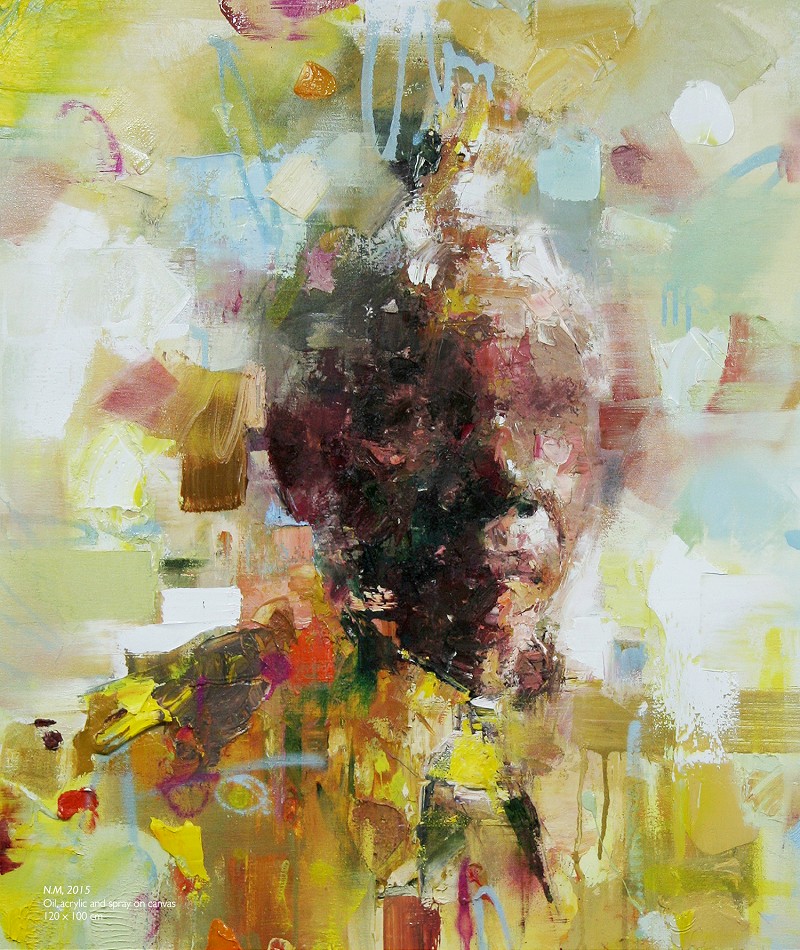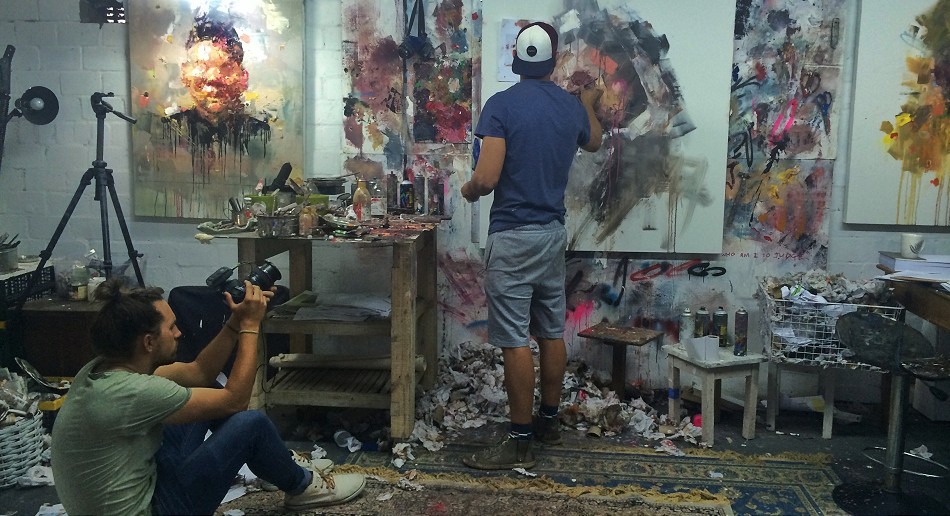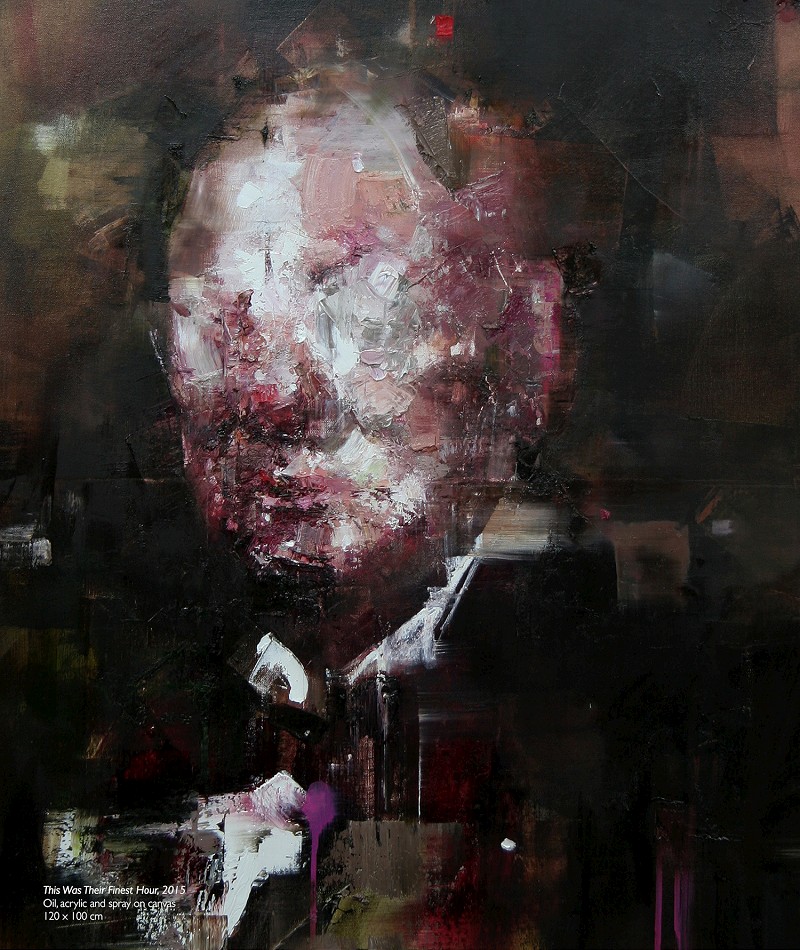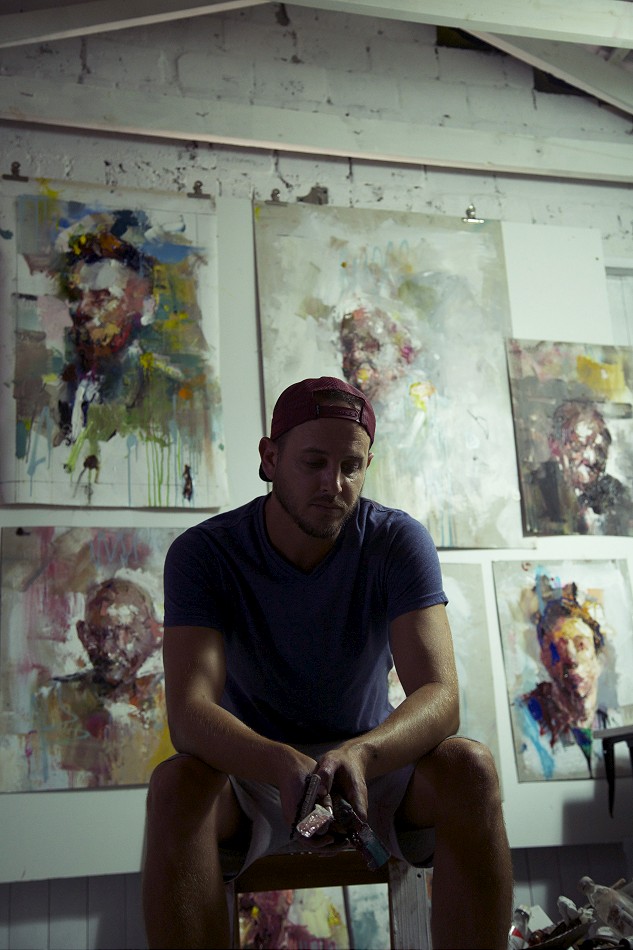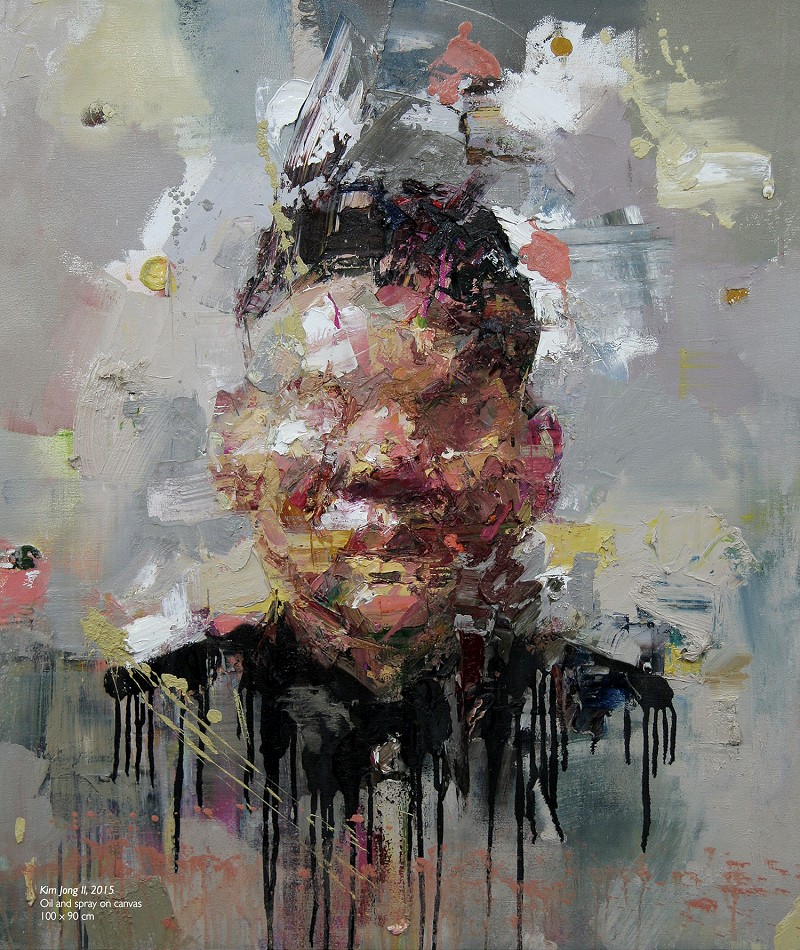Several weeks before opening his long awaited Europen debut on April 24th with The Unit London, we had a chance to talk with Ryan Hewett and have a peek at his process. His upcoming show is called Untitled and it features a collection of portraits of leading figures from the past and present who have somehow shaped civilization. Not limited to good or bad individuals, this unique body of work includes paintings of revered icons as Nelson Mandela, Mahatma Gandhi and Abraham Lincoln, but also Adolf Hitler, Josef Stalin and Osama bin Laden, among others.
We talked with South African painter about his background, his process, the concept of the show, about being an artist in South Africa and about his future plans. Enjoy the questions and answers below…
Arrested Motion (AM): Ryan, please tell us a bit about your artistic education and background?
Ryan Hewett (RH): It’s pretty basic. I took art as a subject in high school, which was essentially drawing and coloring with pencils and copying photos. I had no formal art education, so I’m virtually self-taught in painting. The painting process happened in my early twenties – I took about six months off in between jobs to give myself time to learn how to move paint across the canvas, which was still very much based on my pencil drawings. I started with oil and my first painting – the first one that I looked at and thought, “this is it” – was a profile of an elephant, ha ha. I grew up in a small surfing town, where nobody was interested in art. Art was no more than copying a picture. I started seeking inspiration, researching what other artists were doing overseas. I remember stumbling across The Fantasy Art Masters by Phil Hale, and the author’s illustrations and caricatures in that book completely changed my approach to painting.
AM: How did you end up developing your distinctive style? Was abstract portraiture something you’ve always been interested, or you “grew” into it?
RH: It all started when I was exposed to the illustrations in Phil Hale’s book, which brought me closer to abstract painting and further away from pencil drawing. It’s taken me a long time to get to where I am today; I’ve gone through different periods experimenting with different styles. It didn’t necessarily start with portrait painting. In the beginning, all I wanted was to be able to paint well. It’s such a unique feeling when you start spreading oil on a canvas and the mess accumulates around you. I realised that there was more to painting than simply trying to copy a picture.
AM: So, when did you realize you wanted to be an artist?
RH: I taught myself to paint to the point that I could sell my paintings in a gallery and when that happened, I thought: “OK, this is it, I’m an artist.” I’ve been working as an artist for 15 years now, and it hasn’t been easy. I think my style has evolved into something more abstract and complex. That said, it’s hard to define my style at the moment: whilst it has become progressively looser, equally it has become more defined because it is more layered and I have a better understanding of form. I don’t know what it’s like for other artists, but it’s very difficult to explain my painting process. I don’t necessarily know what I’m looking for with these pieces. The whole experience of painting is often an arduous and unsatisfactory one but, when you achieve the right results, like I did with the Churchill portrait for this exhibition, that one painting alone can keep me going for the next 12 months.
AM: Do you have any artistic role models? Both in history and/or present time.
RH: Past influences: Jean-Michel Basquiat, Francis Bacon, John Singer Sargent. Present influences: Adrian Ghenie.
AM: How does your production process usually look like?
RH: I usually work very quickly so if I’m not achieving results in the first four or five days, I become really frustrated because I know that in a normal situation, I could have painted three or four pieces in that time. I normally find that my best works are those completed in one or two sessions. With this solo exhibition, my process was a bit different because I spent an average of three days per painting, and if I was still working on a panting for any longer than that, I knew I was stuck. The sheer volume of work I had to create forced me for the first time to work on two or three portraits simultaneously, so I was edged out of my comfort zone.
AM: Do you do studies of your works before hand, or is it all coming together at once on a canvas?
RH: I tend to create small paintings that I then translate into a single, larger canvas work. I like to repeat certain portraits with small variations or iterations because I become obsessed with a posture or a look, but I don’t usually produce studies or preliminary paintings beforehand – I just dive straight into it. That approach can be viewed as a sign of confidence, but all it takes is one poor painting for me to lose that confidence very quickly.
AM: Your work seem to have a lot of texture to them. How important is that to you, and how do you apply paint to the canvas?
RH: I’ve learned over time to build layers and to move paint around in order to produce textures. Texture comes from losing the fear to apply paint on the canvas. When I was younger I would have all the paint tubes lined up meticulously and it would take me forever to apply the paint and move that paint with confidence; the prospect of a blank canvas scared me. A portrait without texture can look pretty, but there is still something missing. Texture anchors my paintings – its become an essential element of my work.
AM: What influenced you to create a show consisting of icons of our time?
RH: I don’t think the idea of iconic characters existed from the beginning. I started thinking about portraying religious leaders, political leaders and the dictators of today. There were those three categories and then I thought it would be interesting to focus on the past and present. I struggled with the concept for this show for a good few months because I had never created anything with such a potent theme before, and I’m not a politically driven person either. But, as an artist, I was compelled with this topic, and I felt that it was my duty to assemble all of these characters together in one room. In that sense, they’re humanized because in decontextualising them, they’re all on a level playing field. I’m not here trying to make some huge political statement; UNTITLED is all about stripping away the titles of these figures through the deconstructive nature of my work, so you see the individual before the icon. Any judgement is left to the viewer.
AM: What were the criteria for which icons will be featured in the show?
RH: I started by including figures who I believed were pivotal and influential in the world today, such as Obama. Then I started thinking about past leaders like Lincoln – and then dictators, and so on. I think it’s relatively easy to find 50 individuals that were important in history and who have shaped the world we live in today, but I chose those whom I personally considered most important – those whom I believe have made a mark. I don’t have a precise criteria; these are instinctive choices that I have made as an artist depicting figures who have shaped civilisation.
AM: How was it portraying negative vs. positive characters?
RH: I think it’s essential to portray both. These characters have left their footmark in the world for better or for worse – irrespective of whether they are perceived as good or evil. I think that duality exists in everything and it’s about finding that balance between the two extremes. I remember starting the Hitler painting, and thinking “what am I doing painting Hitler?” I had to remind myself that he was necessary for the show – no one is left out here. In hindsight, the pieces were not as difficult to paint when you view it from that perspective. In fact, I’ve actually enjoyed the process of painting so prolifically for this exhibition; the process of departing from positive beauty and returning to someone who is responsible for genocide was challenging to say the least, but challenge in itself is a positive thing because it pushes you as an artist into new territory, into places you never expected.
AM: When do you decide that the painting is finished?
RH: I often finish a painting and I don’t know how it’s happened – sometimes it feels like the characters painted themselves. That’s why painting Mandela was as challenging as painting Hitler, because it needed to capture the soul, the power of someone who was locked away in prison for 26 years.
AM: Do you feel that being from South Africa influences the subjects of your works? Many of the chosen portraits are having a strong connection to political or racial issues.
RH: I didn’t think about that when I first approached the topic, but it probably does unconsciously. I grew up in the changeover and that’s a big transition for a kid, it’s something that really marks you. All of a sudden, you had these black kids playing with you and you were left wondering, where had these people been? Mandela is obviously such a significant leader for me personally, and the whole subject is probably why Lincoln is included too. This topic may lead to my next body of work for my next show.
AM: What about the other aspects of Africa?
RH: Africa has always had a strong influence in my work. Since I never attended art school, art for me was simply African art. I paint from my heart, as a way to be confident and true to myself.
AM: Your technique requires a lot of self discipline in a way that your work isn’t depicting too many details. How hard was it achieving that level?
RH: It’s the manifestation of years and years of frustration, constant ups and downs… it’s a journey in the evolution of technique, if that’s how you regard painting. If it’s superrealism, there’s a discipline in that, because you’re always pushing boundaries. But I never quite understood that concept. Before, I was seeking detail and had to redefine detail to tackle realism. I’m not a “happy painter” because I’m trying to find this balance all the time, and truthfully, I think my wife is the only person who really understands that struggle. I’m never completely satisfied with my work and that leads to a lot of frustration. If I sit with a problem or I sit with a work for too long, paint dries and it becomes difficult to change, so everything needs to happen in a certain space and time, or I’m in trouble.
AM: How do you decide which features get included in the works as being recognizable enough to represent the subject you’re painting?
RH: It’s by chance. Most of these paintings were built up progressively and then peeled back. It’s an ongoing process of construction and deconstruction. It’s the ability to identify good and bad mistakes, and then question myself: does it capture that person? It’s always rooted in the technique and discipline, the ability to create details and identify them.
AM: How many pieces did you paint for this show? Are they all portraits?
RH: 22 pieces and yes, they’re all portraits.
AM: Is there one that is your favorite and why is that?
RH: I think that the full body of work together holds very strong. As for personal favorites, I would have to say Hitler because it was the very first piece I created for the show. I didn’t know what I was doing at that point but with that piece, everything seemed to fall into place, it just happened. I painted it in a single three hour session and I didn’t have to force it. It was the only painting of the show that I didn’t fight against. I didn’t experience the kind of struggle with Hitler as I did with most of the other portraits, and I think I was trying to find that groove for the rest of the show. That portrait of Hitler set the direction for the rest of the show.
AM: What are your plans for the rest of the year?
RH: I’ll be taking a short break now. This body of works has taken a lot out of me, but I’ll back at the studio pretty quickly – I can’t be out of it for very long. I have a couple of projects planned, and there are group shows and art fairs on the horizon before my next solo show in Cape Town in February 2016.




